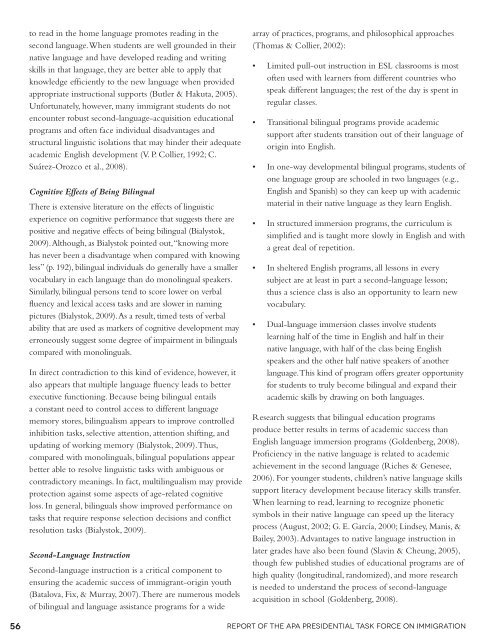Crossroads: The Psychology of Immigration in the New Century
Crossroads: The Psychology of Immigration in the New Century
Crossroads: The Psychology of Immigration in the New Century
You also want an ePaper? Increase the reach of your titles
YUMPU automatically turns print PDFs into web optimized ePapers that Google loves.
to read <strong>in</strong> <strong>the</strong> home language promotes read<strong>in</strong>g <strong>in</strong> <strong>the</strong><br />
second language. When students are well grounded <strong>in</strong> <strong>the</strong>ir<br />
native language and have developed read<strong>in</strong>g and writ<strong>in</strong>g<br />
skills <strong>in</strong> that language, <strong>the</strong>y are better able to apply that<br />
knowledge efficiently to <strong>the</strong> new language when provided<br />
appropriate <strong>in</strong>structional supports (Butler & Hakuta, 2005).<br />
Unfortunately, however, many immigrant students do not<br />
encounter robust second-language-acquisition educational<br />
programs and <strong>of</strong>ten face <strong>in</strong>dividual disadvantages and<br />
structural l<strong>in</strong>guistic isolations that may h<strong>in</strong>der <strong>the</strong>ir adequate<br />
academic English development (V. P. Collier, 1992; C.<br />
Suárez-Orozco et al., 2008).<br />
Cognitive Effects <strong>of</strong> Be<strong>in</strong>g Bil<strong>in</strong>gual<br />
<strong>The</strong>re is extensive literature on <strong>the</strong> effects <strong>of</strong> l<strong>in</strong>guistic<br />
experience on cognitive performance that suggests <strong>the</strong>re are<br />
positive and negative effects <strong>of</strong> be<strong>in</strong>g bil<strong>in</strong>gual (Bialystok,<br />
2009). Although, as Bialystok po<strong>in</strong>ted out, “know<strong>in</strong>g more<br />
has never been a disadvantage when compared with know<strong>in</strong>g<br />
less” (p. 192), bil<strong>in</strong>gual <strong>in</strong>dividuals do generally have a smaller<br />
vocabulary <strong>in</strong> each language than do monol<strong>in</strong>gual speakers.<br />
Similarly, bil<strong>in</strong>gual persons tend to score lower on verbal<br />
fluency and lexical access tasks and are slower <strong>in</strong> nam<strong>in</strong>g<br />
pictures (Bialystok, 2009). As a result, timed tests <strong>of</strong> verbal<br />
ability that are used as markers <strong>of</strong> cognitive development may<br />
erroneously suggest some degree <strong>of</strong> impairment <strong>in</strong> bil<strong>in</strong>guals<br />
compared with monol<strong>in</strong>guals.<br />
In direct contradiction to this k<strong>in</strong>d <strong>of</strong> evidence, however, it<br />
also appears that multiple language fluency leads to better<br />
executive function<strong>in</strong>g. Because be<strong>in</strong>g bil<strong>in</strong>gual entails<br />
a constant need to control access to different language<br />
memory stores, bil<strong>in</strong>gualism appears to improve controlled<br />
<strong>in</strong>hibition tasks, selective attention, attention shift<strong>in</strong>g, and<br />
updat<strong>in</strong>g <strong>of</strong> work<strong>in</strong>g memory (Bialystok, 2009). Thus,<br />
compared with monol<strong>in</strong>guals, bil<strong>in</strong>gual populations appear<br />
better able to resolve l<strong>in</strong>guistic tasks with ambiguous or<br />
contradictory mean<strong>in</strong>gs. In fact, multil<strong>in</strong>gualism may provide<br />
protection aga<strong>in</strong>st some aspects <strong>of</strong> age-related cognitive<br />
loss. In general, bil<strong>in</strong>guals show improved performance on<br />
tasks that require response selection decisions and conflict<br />
resolution tasks (Bialystok, 2009).<br />
Second-Language Instruction<br />
Second-language <strong>in</strong>struction is a critical component to<br />
ensur<strong>in</strong>g <strong>the</strong> academic success <strong>of</strong> immigrant-orig<strong>in</strong> youth<br />
(Batalova, Fix, & Murray, 2007). <strong>The</strong>re are numerous models<br />
<strong>of</strong> bil<strong>in</strong>gual and language assistance programs for a wide<br />
array <strong>of</strong> practices, programs, and philosophical approaches<br />
(Thomas & Collier, 2002):<br />
• Limited pull-out <strong>in</strong>struction <strong>in</strong> ESL classrooms is most<br />
<strong>of</strong>ten used with learners from different countries who<br />
speak different languages; <strong>the</strong> rest <strong>of</strong> <strong>the</strong> day is spent <strong>in</strong><br />
regular classes.<br />
• Transitional bil<strong>in</strong>gual programs provide academic<br />
support after students transition out <strong>of</strong> <strong>the</strong>ir language <strong>of</strong><br />
orig<strong>in</strong> <strong>in</strong>to English.<br />
• In one-way developmental bil<strong>in</strong>gual programs, students <strong>of</strong><br />
one language group are schooled <strong>in</strong> two languages (e.g.,<br />
English and Spanish) so <strong>the</strong>y can keep up with academic<br />
material <strong>in</strong> <strong>the</strong>ir native language as <strong>the</strong>y learn English.<br />
• In structured immersion programs, <strong>the</strong> curriculum is<br />
simplified and is taught more slowly <strong>in</strong> English and with<br />
a great deal <strong>of</strong> repetition.<br />
• In sheltered English programs, all lessons <strong>in</strong> every<br />
subject are at least <strong>in</strong> part a second-language lesson;<br />
thus a science class is also an opportunity to learn new<br />
vocabulary.<br />
• Dual-language immersion classes <strong>in</strong>volve students<br />
learn<strong>in</strong>g half <strong>of</strong> <strong>the</strong> time <strong>in</strong> English and half <strong>in</strong> <strong>the</strong>ir<br />
native language, with half <strong>of</strong> <strong>the</strong> class be<strong>in</strong>g English<br />
speakers and <strong>the</strong> o<strong>the</strong>r half native speakers <strong>of</strong> ano<strong>the</strong>r<br />
language. This k<strong>in</strong>d <strong>of</strong> program <strong>of</strong>fers greater opportunity<br />
for students to truly become bil<strong>in</strong>gual and expand <strong>the</strong>ir<br />
academic skills by draw<strong>in</strong>g on both languages.<br />
Research suggests that bil<strong>in</strong>gual education programs<br />
produce better results <strong>in</strong> terms <strong>of</strong> academic success than<br />
English language immersion programs (Goldenberg, 2008).<br />
Pr<strong>of</strong>iciency <strong>in</strong> <strong>the</strong> native language is related to academic<br />
achievement <strong>in</strong> <strong>the</strong> second language (Riches & Genesee,<br />
2006). For younger students, children’s native language skills<br />
support literacy development because literacy skills transfer.<br />
When learn<strong>in</strong>g to read, learn<strong>in</strong>g to recognize phonetic<br />
symbols <strong>in</strong> <strong>the</strong>ir native language can speed up <strong>the</strong> literacy<br />
process (August, 2002; G. E. García, 2000; L<strong>in</strong>dsey, Manis, &<br />
Bailey, 2003). Advantages to native language <strong>in</strong>struction <strong>in</strong><br />
later grades have also been found (Slav<strong>in</strong> & Cheung, 2005),<br />
though few published studies <strong>of</strong> educational programs are <strong>of</strong><br />
high quality (longitud<strong>in</strong>al, randomized), and more research<br />
is needed to understand <strong>the</strong> process <strong>of</strong> second-language<br />
acquisition <strong>in</strong> school (Goldenberg, 2008).<br />
56 Report <strong>of</strong> <strong>the</strong> APA Presidential Task Force on <strong>Immigration</strong>
















